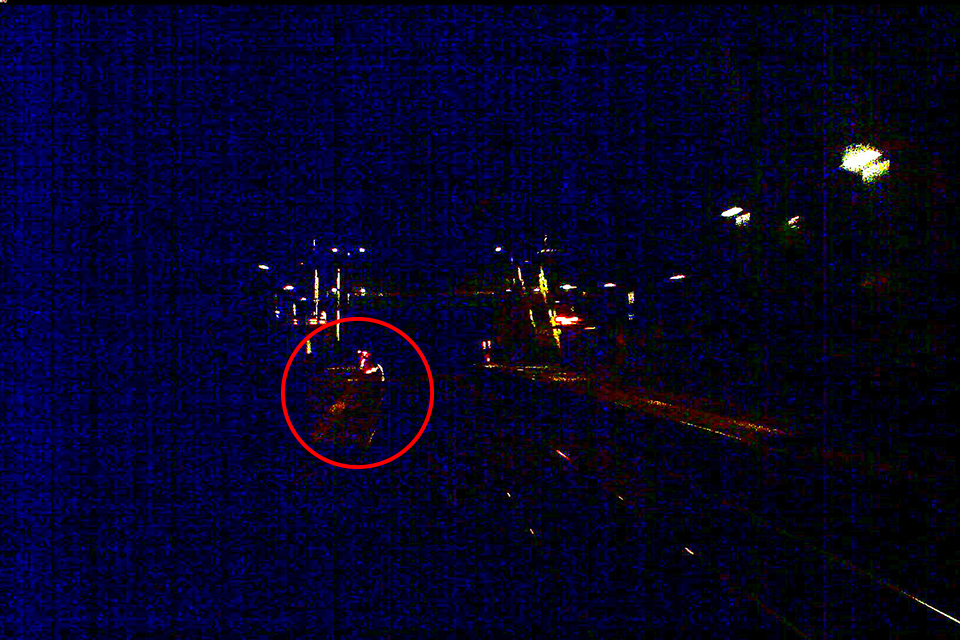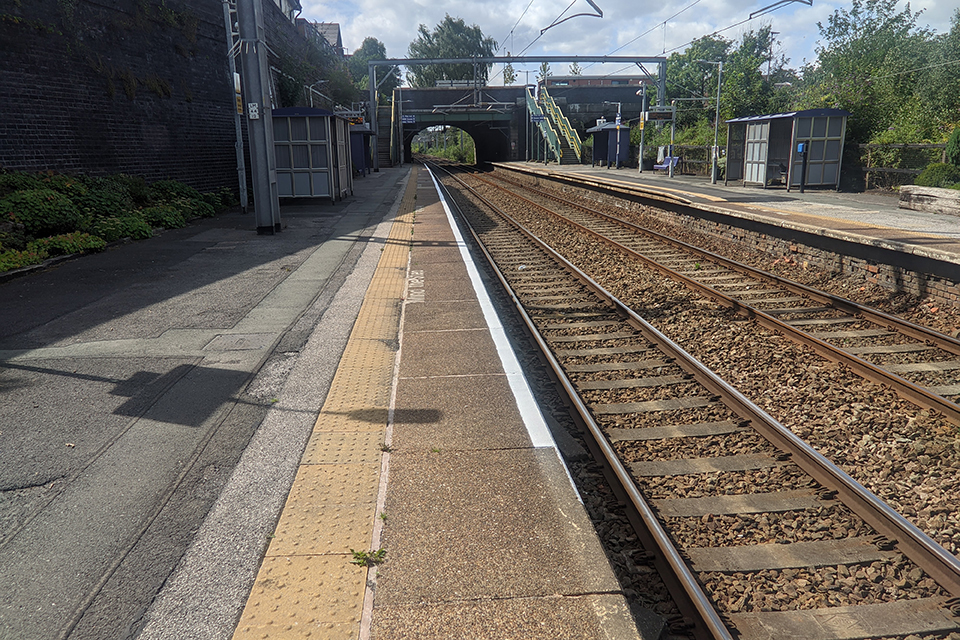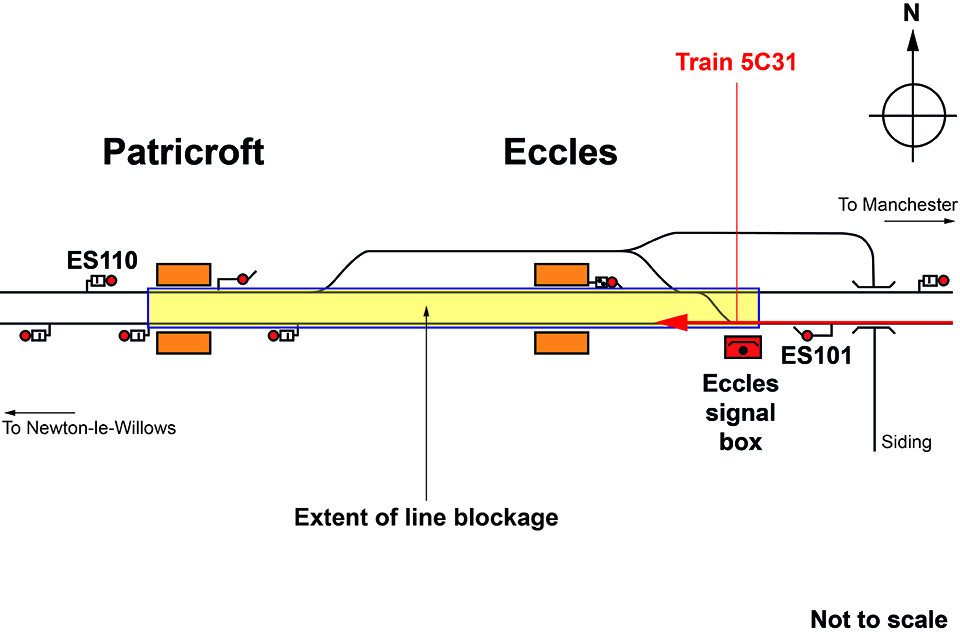Near miss with track workers at Eccles, 22 July 2021
Published 30 September 2021
1. Important safety messages
This incident demonstrates the importance of:
-
the COSS remaining with their work group at all times while they are on or near the line in order to be able to personally observe and advise them
-
the COSS ensuring that all persons in their work group working on or near the line have moved to a position of safety, or are otherwise adequately protected by a safe system of work, before they hand back a line blockage
-
train drivers sounding the warning horn when track workers are seen on or near the line, which on this occasion probably averted a double fatality
2. Summary of the incident
At around 04:12 hrs, during the hours of darkness, two track workers were standing on the westbound track at Eccles station, adjacent to Platform 2, when an empty passenger train approached them from the direction of Manchester. The track workers had been working under the protection of a line blockage that had been taken by the Controller of Site Safety (COSS), who was responsible for ensuring that the track workers were protected from train movements. The track workers had been standing on the track to paint a white line along the edge of Platform 2. They had just been told to stop work and were preparing to leave the track when the train approached.
The train involved, reporting number 5C31, was operated by Avanti West Coast Ltd. It consisted of a Class 390 electric multiple unit which was travelling from Longsight depot, in Manchester, to Lancaster. On approaching Eccles and seeing the track workers’ reflective clothing, the train driver sounded the train’s horn and applied the emergency brake. The track workers heard the warning horn and quickly climbed onto the platform. They were clear of the track approximately four seconds before the train passed them while travelling at 69 mph (111 km/h).
The train came to a stop and the driver reported the near miss to the signaller. After seeing the train pass and come to a stop, the COSS also called the signaller to notify him of the incident. The signaller instructed the COSS to stop work and sent Network Rail response staff to the station to investigate.

Forward facing CCTV from train 5C31 showing track workers on the platform edge (Image courtesy of Avanti West Coast Ltd)
Although no-one was injured, the track workers and the train driver were badly shaken by the near miss.
3. Cause of the incident
The incident occurred because the COSS had given up the line blockage before informing the track workers that they had to move clear of the line and making sure that they had done so.
The work on the platform was being undertaken on behalf of Northern Trains Ltd, the operator of Eccles station. It was contracted to TMT Commercial Contractors Ltd, who planned the white-lining task and employed the track workers. TMT Commercial Contractors Ltd subcontracted the provision of safety-critical staff and the planning of the safe system of work to Trackwork Ltd. The COSS was a contractor who was supplied to Trackwork Ltd by an agency, Spectrum Rail Ltd. He had been certified as competent to undertake the role of COSS for approximately ten years and regularly acted in the role. The COSS was also the nominated Person In Charge and therefore had overall responsibility for safely delivering the work.
The COSS and the track workers had undertaken similar work at other stations on the previous three nights. They had also carried out the same work at Patricroft station, the station directly to the west of Eccles, earlier on the night of the incident.

Eccles station platform 2 looking west, with bridge access in the distance
The work was planned to be undertaken using a Safeguarded safe system of work, where every line at the site of work would be blocked to normal train movements. This would be established using a line blockage that covered both Patricroft and Eccles stations. No additional protection (such as disconnecting signalling equipment, using a lock-out device or placing detonators) was planned for the line blockage.
The line blockage covered both lines and was protected by signal ES101, just to the east of Eccles station and signal ES110, to the west of Patricroft station. The work was planned to run from 00:01 hrs to 05:00 hrs, with the line blockage being given up to allow trains to pass when required. Discussions between the COSS and the signaller at the start of the night confirmed that scheduled trains were running and that the work would need to stop and the line blockage be given up for each train.
Recordings of the conversations between the signaller and the COSS showed that the standard of safety critical communications between them was generally good and that the signaller ensured that Network Rail’s communication protocols were followed. Calls to both take and hand back the line blockage had durations of between two and eight minutes.

Track diagram showing the extent of the line blockage
Prior to the passage of train 5C31 the COSS had given up and reinstated the line blockage on two occasions to allow scheduled trains to pass. CCTV evidence shows that the COSS was with the work group and confirmed that the track workers were clear of the line before he gave up the line blockage on both occasions.
The COSS had two mobile telephones with him on the night of the incident and he was using one as his primary contact number for conversations with the signaller. However, at 03:27 hrs, he told the signaller that his battery was running low in his primary mobile telephone. He provided contact details for the second mobile telephone as a fall-back measure and then went to his vehicle, which was near to the top of the access steps to the platform, to charge his primary mobile phone. The COSS stood by his vehicle to allow him to check on his primary mobile phone while it was charging.
It was from this location that the COSS called the signaller at 04:09 hrs, as previously agreed, to hand the line blockage back. At 04:10 hrs the COSS stated to the signaller that all staff were clear and that the line was safe to operate trains. However, witness evidence shows that the COSS had not yet told the trackworkers to stop work and move to their position of safety on the platform when he said this. When the call to the signaller ended at 04:11 hrs, the COSS immediately used his mobile telephone to call the trackworkers and told them to stop work and move clear of the line. This call had just ended when the track workers heard the horn of the approaching train.
Railway rules and standards include two specific requirements intended to prevent this type of near miss that were applicable to the incident:
-
Rule Book Handbook 8 Issue 7 ‘IWA, COSS or PC blocking a line’ states that ‘when the line blockage is to be given up or is to be suspended, you must … make sure that any work that is to continue does not need a line blockage’.
-
Rule Book Handbook 7 Issue 7 ‘General duties of a controller of site safety (COSS)’ also requires that the COSS should ‘stay with your group so that you are able to personally observe and advise everyone until … work is completed and your group is no longer on or near the line’.
RAIB also notes that a much more serious accident was probably averted by the driver’s prompt use of the train horn to sound a warning when he saw the track workers’ reflective high-visibility clothing ahead.
4. Previous similar occurrences
RAIB published its report on a class investigation into accidents and near misses involving trains and track workers outside possessions in April 2017 (RAIB report 07/2017). This highlighted that COSS distraction by other tasks was a recurring factor. It also recognised that although the provision of additional protection for line blockages had to be considered, it was often not used because it would need too much time to set up and remove.
On 12 June 2011, a track worker was injured after being struck by a train at Stoats Nest Junction, south of Croydon (RAIB report 16/2012). The work site was handed back to the signaller and trains allowed to resume while work continued on the track. The COSS was not with the work group while this happened. RAIB recommended that Network Rail should expedite the improvement of safety leadership for its track maintenance staff. The Office of Rail and Road has reported to RAIB that Network Rail had started three programmes to improve safety culture and leadership for such staff.
On 7 April 2017, two track workers narrowly avoided being struck by a train at Ascot station while working on a line that they mistakenly believed was blocked to trains. The circumstances are described in RAIB safety digest 09/2017. A miscommunication between staff meant that the COSS had thought that a line blockage was in place when it had not yet been taken. This highlighted the importance of effective communications within work teams when managing line blockages.

